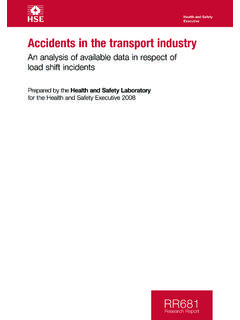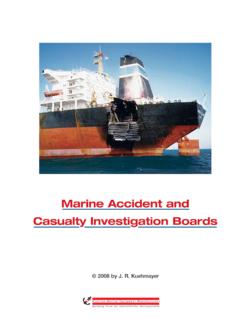Transcription of Bridge Watchkeeping Safety Study - maritimeconsultant.com
1 Bridge WBridge Watchkeeping Safety Satchkeeping Safety StudytudyMarine Accident Investigation BranchFirst FloorCarlton HouseCarlton PlaceSouthamptonUnited Kingdom SO15 2 DZSafety Study 1/2004 July 2004 Extract from The Merchant Shipping (Accident Reporting and Investigation)Regulations 1999 The fundamental purpose of investigating an accident under these Regulations is todetermine its circumstances and the cause with the aim of improving the Safety of lifeat sea and the avoidance of accidents in the future. It is not the purpose to apportionliability, nor, except so far as is necessary to achieve the fundamental purpose, toapportion blameNoteThis report is not written with liability in mind and is not intended to be used in court forthe purpose of litigation.
2 It endeavours to identify and analyse the relevant safetyissues pertaining to the specific accident, and to make recommendations aimed atpreventing similar accidents in the future. CONTENTSCONTENTSPageGLOSSARY OF ABBREVIATIONS AND TERMSEXECUTIVE SUMMARY1 BACKGROUND2 METHODOLOGY3 OVERVIEW4 ANALYSIS8 Groundings8 Manning levels and fatigue10 Collisions15 Lookout17 Use of radar21 The use of sound signals and VHF22 Safe manning23 The role of the master24 The principles of safe manning25 CONCLUSIONS27 RECOMMENDATIONS28 Annex A - QuestionnaireAnnex B - Annexes to IMO Resolution (21)
3 Principles of safe manningGLOSSARGLOSSARYYOF TERMS OF TERMS AND AND ABBREVIAABBREVIATIONSTIONSAIS-Automatic Identification SystemARPA-Automatic Radar Plotting AidCOLREGS-International Regulations for Preventing Collisions at Seagt-Gross registered tons (measurement of volume)IMO-International Maritime OrganizationISPS-International Ship and Port Facility Security CodeITF-International Transport FederationMAIB-Marine Accident Investigation BranchMCA-Maritime and Coastguard AgencyOMBO-One Man Bridge OperationOOW-Officer of the WatchSOLAS- Safety of Life at SeaSTCW-Standards of Training, Certification and WatchkeepingUK-United KingdomUMS-Unmanned Machinery SpaceVHF-Very High Frequency (radio)
4 EXECUTIVE SUMMAREXECUTIVE SUMMARYYAt 0515, on 29 June 2003, the general dry cargo vessel Jambo ran aground, andsubsequently sank, at the entrance to Loch Broom on the west coast of Scotland. Thevessel was carrying 3,300 tonnes of zinc concentrate, prompting fears of anenvironmental disaster (Report 27/2003). This was the latest in a series of remarkablysimilar accidents, the common features of which included fatigued officers, one manbridge operation at night, missed course alterations and no watch Study was commissioned to establish the principal factors that cause nauticalaccidents, and to consider whether fatigue is as prevalent and dangerous as indicatedby the Jamboand similar accidents.
5 The Study has reviewed in detail the evidence of 65 collisions, near collisions,groundings and contacts that were investigated by the Branch. It has confirmed thatminimal manning, consisting of a master and a chief officer as the only twowatchkeeping officers on vessels operating around the UK coastline, leads towatchkeeper fatigue and the inability of the master to fulfil his duties, which, in turn,frequently lead to accidents. It has also found that standards of lookout in general arepoor, and late detection or failure to detect small vessels is a factor in many Study concludes that the current provisions of STCW 95 in respect of safemanning, hours of work and lookout are not have been directed at the MCA to take the conclusions of the studyforward to the IMO with the aim of reviewing:1.
6 The guidelines on safe manning, to ensure that all merchant vessels over 500gt havea minimum of a master plus two Bridge Watchkeeping officers, unless specificallyexempted for limited local operations as approved by the The requirements of STCW 95 to change the emphasis with respect to the provisionof a designated lookout to ensure that a lookout is provided on the Bridge at all times,unless a positive decision is taken that, in view of daylight and good visibility, lowtraffic density and the vessel beingwell clear of navigational dangers, asole watchkeeper would be able tofulfil the The requirements of STCW 95 sothat a Bridge lookout can be moreeffectively utilised as an integralpart of the Bridge the 10 years, 1994 to 2003 inclusive, 652 collisions and groundings involvingmerchant vessels of over 500gt, were reported to the MAIB under the UK s MerchantShipping (Accident Reporting and Investigation) Regulations.
7 There were also 995near collisions (hazardous incidents) voluntarily reported during this time, 342 of whichwere between fishing vessels and merchant vessels of over 500gt. Twenty-two peoplehave lost their lives in collisions involving merchant vessels since the MAIB beganrecording data. Many of these accidents and incidents were the subject of a full MAIB investigation. Following publication of these reports, and those of other investigatingauthorities, numerous press headlines have reflected the concerns of the industry,typically: Officers facing overload (NUMAST Telegraph October 2003) Is Anyone Awake?
8 (Lloyds List, July 2003) UK takes hard line on OMBO (NUMAST Telegraph Nov 1998) Waking up to the nightmare of the sleepless ship s officer (Lloyds List Feb1997) Fatigue on board kills (ITF Maritime News 1997) Collision regulations flouted ( Safety at Sea April 1997) Collision highlights ships inadequate manning levels (Lloyds Casualty WeekMay 1998) Did good traditions of Seamanship go out with the ark? ( Safety at Sea Nov2000) Watchkeeping flaws worry British yachting chiefs (Lloyds List January2001).Even a cursory consideration of relevant investigations shows that a small number ofcausal factors are common to nearly all Bridge Watchkeeping accidents.
9 The purpose of this Study is to collate the underlying human factors involved in a largenumber of accidents investigated by the MAIB, to graphically illustrate the principalshortfalls in Bridge Watchkeeping . The Study s overall objective is to producearguments for change that will result in an improvement in the Safety of this key areaof marine operational accidents included in the data for this Study were selected using the followingcriteria:All collisions, groundings, contacts and near collisions reported to theMAIB, which : occurred between 1994 and 2003; were the subject of an MAIB investigation or PreliminaryExamination; involved a merchant vessel of over 500gt.
10 Occurred in coastal waters, port/harbour area or high seas,where :the vessel was underway; and,a licensed pilot was not factors influenced the use of these criteria. First, the MAIB had collectedaccident data since it was founded in 1989, but the quality of this data improvedconsiderably in 1994, following a review of its investigation techniques and databasemanagement. Second, the Study was restricted to the analysis of accidents which hadbeen fully investigated or were the subject of a preliminary examination because of thedetailed and accurate data provided by these cases.





